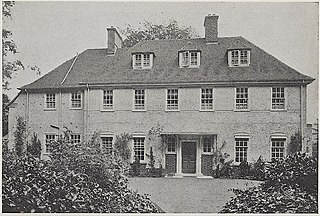
Sir Giles Gilbert Scott was a British architect known for his work on the New Bodleian Library, Cambridge University Library, Lady Margaret Hall, Oxford, Battersea Power Station, Liverpool Cathedral, and designing the iconic red telephone box.

Whittington Hospital is a district general and teaching hospital of UCL Medical School and Middlesex University School of Health and Social Sciences. Located in Upper Holloway, it is managed by Whittington Health NHS Trust, operating as Whittington Health, an integrated care organisation providing hospital and community health services in the north London boroughs of Islington and Haringey. Its Jenner Building, a former smallpox hospital, is a Grade II listed building.

Sir Reginald Theodore Blomfield was a prolific British architect, garden designer and author of the Victorian and Edwardian period.

The region of Greater London, including the City of London, is divided into 75 parliamentary constituencies which are sub-classified as borough constituencies, affecting the type of electoral officer and level of expenses permitted. Since the general election of July 2024, 59 are represented by Labour MPs, 9 by Conservative MPs, 6 by Liberal Democrat MPs, and 1 by an independent MP.

The London Lock Hospital was the first voluntary hospital for venereal disease. It was also the most famous and first of the Lock Hospitals which were developed for the treatment of syphilis following the end of the use of lazar hospitals, as leprosy declined. The hospital later developed maternity and gynaecology services before being incorporated into the National Health Service in 1948 and closing in 1952.

Thomas Smith Tait was a Scottish modernist architect. He designed a number of buildings around the world in Art Deco and Streamline Moderne styles, notably St. Andrew's House on Calton Hill, Edinburgh, and the pylons for Sydney Harbour Bridge.

West Middlesex University Hospital (WMUH) is an acute NHS hospital in Isleworth, West London, operated by Chelsea and Westminster Hospital NHS Foundation Trust. It is a teaching hospital of Imperial College School of Medicine and a designated academic health science partner. West Middlesex University Hospital serves patients in the London Boroughs of Hounslow, Richmond upon Thames and Ealing. The hospital has over 400 beds and provides a full range of clinical services including accident and emergency, acute medicine, care of the elderly, surgery and maternity.

London Buses route 137 is a Transport for London contracted bus route in London, England. Running between Streatham Hill and Marble Arch station, it is operated by Arriva London.
Sir George Douglas Pinker, KCVO was an internationally respected obstetrician and gynecologist, best known for modernizing the delivery of royal babies.

John Erskine Clarke (1827–1920) was a British clergyman who issued the first parish magazine. He established several other religious publications and was responsible for founding churches schools and hospitals in Battersea. He also competed at Henley Royal Regatta.

John Giles was a British architect. He was born in Lincoln, probably in 1830, and his family came from Branston near Lincoln. He was articled to the Lincoln architect Pearson Bellamy. He had moved to London by 1859 and with Pearson Bellamy entered a number competitions for major public buildings. Of these only one, for Grimsby Town, was successful. In London he was responsible for a number of major projects including the Langham Hotel. He also started in 1869 on the design of hospitals with the Infirmary to Hampstead Union Workhouse. After a short period of partnership with Lewis Angel, when Stratford Town Hall was built and with Edward Biven, by 1873 he was in partnership with Albert Edward Gough. They were joined in the practice by J E Trollope and they became involved in the design of Arts and Crafts housing in London's west end. Giles had business interests in the City of London and was noted in 1867 as being a Director of the Imperial Guardian Life Insurance Company.

Oswald Partridge Milne FRSA FRIBA was a British architect.

John McKean Brydon was a Scottish architect who developed a practice in designing public buildings, particularly hospitals, in London. He designed the St Peter's Hospital in Henrietta Street, Covent Garden (1880–84), the Hospital for Women in Euston Road, Chelsea Public Library (1890), and the London School of Medicine for Women in Huntley Street (1896). He also designed the Old Vestry Hall at the rear of the Chelsea Town Hall on King's Road, as well as the Government Offices Great George Street, which today house the Treasury, HM Revenues and Customs and part of the Cabinet Office.
Healthcare in London, which consumes about a fifth of the NHS budget in England, is in many respects distinct from that in the rest of the United Kingdom, or England.
The following outline is provided as an overview of and topical guide to the city known as London:
This is a list of coats of arms of London.

















